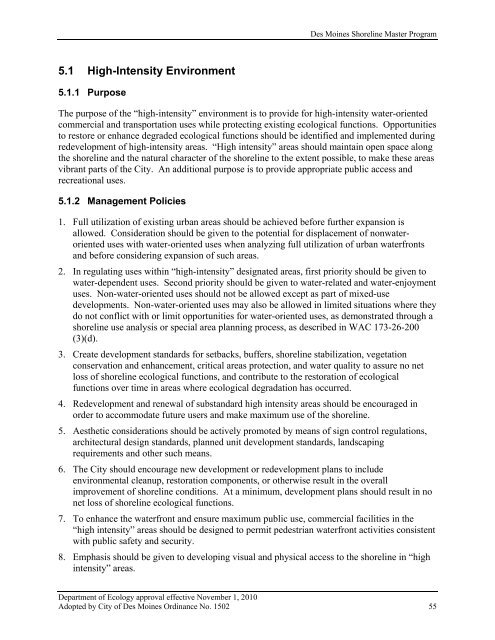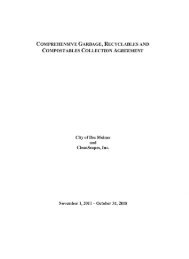CITY OF DES MOINES SHORELINE MASTER PROGRAM
CITY OF DES MOINES SHORELINE MASTER PROGRAM
CITY OF DES MOINES SHORELINE MASTER PROGRAM
Create successful ePaper yourself
Turn your PDF publications into a flip-book with our unique Google optimized e-Paper software.
Des Moines Shoreline Master Program<br />
5.1 High-Intensity Environment<br />
5.1.1 Purpose<br />
The purpose of the “high-intensity” environment is to provide for high-intensity water-oriented<br />
commercial and transportation uses while protecting existing ecological functions. Opportunities<br />
to restore or enhance degraded ecological functions should be identified and implemented during<br />
redevelopment of high-intensity areas. “High intensity” areas should maintain open space along<br />
the shoreline and the natural character of the shoreline to the extent possible, to make these areas<br />
vibrant parts of the City. An additional purpose is to provide appropriate public access and<br />
recreational uses.<br />
5.1.2 Management Policies<br />
1. Full utilization of existing urban areas should be achieved before further expansion is<br />
allowed. Consideration should be given to the potential for displacement of nonwateroriented<br />
uses with water-oriented uses when analyzing full utilization of urban waterfronts<br />
and before considering expansion of such areas.<br />
2. In regulating uses within “high-intensity” designated areas, first priority should be given to<br />
water-dependent uses. Second priority should be given to water-related and water-enjoyment<br />
uses. Non-water-oriented uses should not be allowed except as part of mixed-use<br />
developments. Non-water-oriented uses may also be allowed in limited situations where they<br />
do not conflict with or limit opportunities for water-oriented uses, as demonstrated through a<br />
shoreline use analysis or special area planning process, as described in WAC 173-26-200<br />
(3)(d).<br />
3. Create development standards for setbacks, buffers, shoreline stabilization, vegetation<br />
conservation and enhancement, critical areas protection, and water quality to assure no net<br />
loss of shoreline ecological functions, and contribute to the restoration of ecological<br />
functions over time in areas where ecological degradation has occurred.<br />
4. Redevelopment and renewal of substandard high intensity areas should be encouraged in<br />
order to accommodate future users and make maximum use of the shoreline.<br />
5. Aesthetic considerations should be actively promoted by means of sign control regulations,<br />
architectural design standards, planned unit development standards, landscaping<br />
requirements and other such means.<br />
6. The City should encourage new development or redevelopment plans to include<br />
environmental cleanup, restoration components, or otherwise result in the overall<br />
improvement of shoreline conditions. At a minimum, development plans should result in no<br />
net loss of shoreline ecological functions.<br />
7. To enhance the waterfront and ensure maximum public use, commercial facilities in the<br />
“high intensity” areas should be designed to permit pedestrian waterfront activities consistent<br />
with public safety and security.<br />
8. Emphasis should be given to developing visual and physical access to the shoreline in “high<br />
intensity” areas.<br />
Department of Ecology approval effective November 1, 2010<br />
Adopted by City of Des Moines Ordinance No. 1502 55



